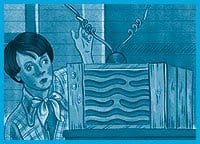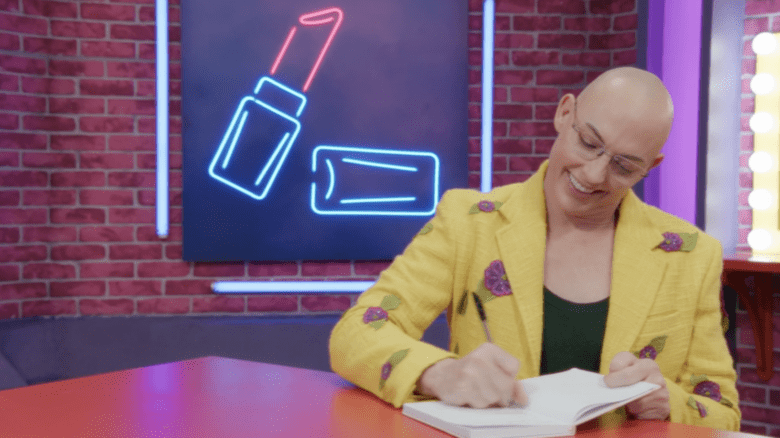This year, there’s so much going on of interest to queer folk at the Images festival, a showcase of independent film, video, new media, performance and installation, that there’s barely room to mention it all. So let’s dive right in.
The festival’s Canadian Artist Spotlight is a survey of works by local video artist Leslie Peters. Included are several works from her 400 series, some more recent works and her directorial collaborations with Lisa Foad and Dara Gellman.
Personally I find the films of the 400 series, works from 1998 and ’99, to be the most satisfying. Each is an abstraction of a short drive down a highway, the camera passively along for the ride. What’s going on here is partly the familiar made strange. The highway in 401:01, for example, is recognizable mostly because of the ubiquitous white line that runs along the side of the road, otherwise, it just looks like horizontal and vertical lines rushing past. The road in Thinking Of You is punctuated by hyper-real images of trucks passed.
There’s also a theme of “sameness” going on; the single shots are really quite monotonous (it’s like a more beautiful, less dangerous version of highway hypnosis). And, at the same time, the sameness is undercut by the implication of travel, for these are, at the same time, transit pieces that take us from A to B, and therefore the very definition of change. Regardless of any of the works’ theoretical underpinnings, they are stunningly lovely to look at.
Newer pieces are more stripped down and meditative. Seed, from 2002, focusses on a field at daybreak. Basin, also from 2002, features imagery of rushing water overlaid, reversed, zooming in and out. Last year’s Divine is a sedate view of two large birds standing in a river that the viewer only gradually becomes aware of. We wait for the only logical action and eventually it comes as the birds fly away. Beautiful.
Surge-o-matic, Peters’ collaboration with Foad, elaborates somewhat on the theme of sameness that runs through the 400 series; it features fast-paced intercut footage of two women cooking, cleaning and making themselves up. By matching the images of one cut to the next, all of these actions seem like the same thing. Very funny. Who knew that you could make preparing Jell-O seem the same as scrubbing the toilet? But note that these actions are all “women’s work.” Is putting on make-up the same drudgery as making a cake?
Interference, made with Gellman, is a rather more ambitious and dark piece that uses TV footage of crime scenes to expose the underside of suburbia. An oft-visited subject, certainly, but the calmness of the approach here makes the danger seem all the more hidden and fascinating. It’s difficult to put your finger on, but any queer who grew up in Scarborough (or any other Canadian suburb) will have special recognition of the menace exposed in this piece.
Peters’ work is powerful and fascinating and not to be missed. The Spotlight shows at Innis Town Hall (2 Sussex Ave) on Fri, Apr 16 at 7pm. Images also presents Peters’ installation Becoming at the Women’s Art Resource Centre (401 Richmond St W, #122) till Apr 21.
Craig Marshall’s Touch Me Now is a take on Internet dating featuring an animated fella giving orders that are loosely organized around the lyrics of the Samantha Fox hit that gives the piece its name. Daniel Olson’s Snow Job looks at first like nothing but a man reading a newspaper, but this is one of those cinematic trompe l’oeil that shows its cards at the last minute. I had to watch it a second time and yes, you can see him naked all the way through. Pustulations, an animated piece by Lisa Morse, examines a woman’s fascination with the pus that collects below her skin. With specific exceptions, I’m no fan of bodily fluids, but with its repugnantly familiar reds and yellows, this piece is gross fun to watch. Christina Zeidler’s Kill Road is the tale of a young girl’s anguish at her parents attempts to revive a raccoon they inadvertently hit on the road. I’m not sure what’s funnier, the premise or seeing Lex Vaughn play the rigor mortis-stiffened raccoon. The shorts screen at Innis Town Hall on Sat, Apr 24 at 7pm.
Pangyau is a moving work by Amir Muhammad that looks at a friendship between two men who manage to bridge gaps of race, religion and language: one is a Malay Muslim, the other Chinese. The friendship becomes intimate, but ends when the Chinese fellow leaves Malaysia for Australia. The story is voiced over random images of markets and food stalls in Kuala Lumpur (Innis Town Hall, Sat, Apr 24, 3pm). See page 29 for John Greyson’s video installation.
Barbara Hammer will be in attendance with Resisting Paradise, digging in the muck of the discarded to find the bits that show us what history has forgotten. Those familiar with her work, Nitrate Kisses and History Lessons are recent examples, know how astute she is at creating historical space for women in general and lesbians in particular. She’s in fine form here, focussing on Cassis, the French town famous for the quality of light so lauded by the likes of Henri Matisse. His letters are among the documents Hammer uses. But she unearths resistance actions going on in the town during World War II, some involving Madame Matisse and the artist’s daughter. The central question becomes the role of art and the artist during wartime (Innis Town Hall, Sun, Apr 18, 7pm).
The festival includes lots of installation pieces, including one that’s all new media work. Queer German artist Michael Brynntrup presents Silent Film For Deaf People (see it at Brynntrup.de/stummfilm). Local hero Richard Fung’s piece is called Installation With F-16’s, Apache Helicopters And Rock Doves – that should surely be enough to get you out to have a look (Wynick/Tuck Gallery, 401 Richmond St W, from Sat, Apr 17 to May 8).
The festival goes out with a bang at its closing gala at Innis Town Hall on Sat, Apr 24 at 9:15pm. Featured is the work of Winnipeg-based Daniel Barrow, who I’ll call a projection artist. Barrow presents The Face Of Everything, his 2002 tale of the late-adolescent protegé of a Liberace-esque entertainer (based on a true story), written and narrated live by the artist, illustrated on (of all things) an overhead projector with multiple drawings that are manipulated in concert with the narration (check out the video Barrow did for The Hidden Cameras at Muchmusic.com).
The whole thing is so low-tech – literally putting images in front of light and speaking into a mic – that part of the pleasure of the experience is realizing that you are being overwhelmed and drawn into something that is very simple despite its intricacy (these are stories that gestate in Barrow’s mind for years and take a good nine months at least to prepare once the script is ready). You couldn’t be much further away from The Matrix-esque FX that are so cooed over, and the effect is way more mesmerizing. It’s like a return to proto-cinema; now (as then) it’s practically impossible to describe the wonderful newness of this experience (always a recommendation in my estimation).
The overhead projector throws you back to geography class circa grade six – very calming in its familiarity, a factor increased by the lined exercise paper on which the illustrations are drawn. It’s like you’re sitting in class, passing notes with your funniest, smartest friend. All of this evokes an immediacy which belies the fact that it has all been painstakingly prepared over months.
Barrow says his technique in fact comes directly from the classroom. “I was taking art history classes with a nun,” says Barrow; her teaching method involved showing slides and reading from notes. “Then she would turn on an overhead projector and everything she had just said was condensed on the overhead and she would stand beside it and crank the scroll. The combination of her hypnotic voice and the scrolling text was really beautiful and really relaxing.”
Barrow’s work stays true to this sense of beauty and relaxation, though lecture has been replaced by rather mad narrative. The Face Of Everything includes such facial troubles as acne medications that fail and plastic surgery gone wrong. “Liberace,” Barrow explains, “had a history of asking people to surrender their identity to him and would even go so far as to ask them to have plastic surgery so they would look more like Liberace.”
Sometimes terribly poignant, at moments wickedly funny, The Face Of Everything is, perhaps, at its base a coming-of-age tale for the meandering homo – and as such, appropriately ends on a campy note of damaged hope, or is it hopeful damage? The face of queerdom, no doubt.
IMAGES.
$8 regular. $12 gala. $75 pass.
Thu, Apr 15-24.
(416) 971-6236.
Imagesfestival.com.

 Why you can trust Xtra
Why you can trust Xtra


